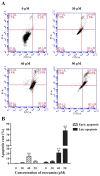Apoptosis of mouse myeloma cells induced by curcumin via the Notch3-p53 signaling axis
- PMID: 30655747
- PMCID: PMC6313093
- DOI: 10.3892/ol.2018.9591
Apoptosis of mouse myeloma cells induced by curcumin via the Notch3-p53 signaling axis
Abstract
Resistance to apoptosis is a characteristic of cancer. Curcumin has become a potential anticancer drug for its pro-apoptotic effects, but the underlying mechanisms remain unclear. Furthermore, the Notch3-p53 signaling axis serves an important role in cell fate. The present study was designed to investigate the antitumor effect of curcumin by the Notch3-p53 axis in mouse myeloma P3X63Ag8 cells. The effects of curcumin on the viability of P3X63Ag8 cells were evaluated using an MTT assay. Quantitative expression of the Notch3-p53 signaling axis-associated genes was measured by reverse transcription-quantitative polymerase chain reaction, and western blot analysis was used to investigate the expression of proteins. Additionally, flow cytometry was used to measure the ratio of apoptosis. The results demonstrated that curcumin could significantly inhibit cell viability. No significant pro-apoptotic effect was observed when the concentration of curcumin was <30 µM. At 30 µM, curcumin-treated cells exhibited an apoptotic phenomenon, and the ratio of late apoptosis increased with the concentration of curcumin, and reached 28.4 and 51.8% in the medium- and high-dose groups, respectively. Curcumin inhibited the expression of Notch3, while the middle- and high-dose groups promoted p53. The expression of Notch3-responsive genes Hes family BHLH transcription factor 1 and Hes-related family transcription factor with YRPW motif 1 were notably promoted. Curcumin treatment significantly downregulated B-cell lymphoma-2 (Bcl-2) at the mRNA and protein levels, but upregulated Bcl-2-associated X. These data indicated that curcumin exhibited antitumor effects in mouse myeloma cells with induction of apoptosis by affecting the Notch3-p53 signaling axis.
Keywords: Notch3; P3X63Ag8 cell; apoptosis; curcumin; p53.
Figures




Similar articles
-
Synthesis of sophocarpine triflorohydrazone and its proliferation inhibition and apoptosis induction activity in myeloma cells through Notch3-p53 signaling activation.Environ Toxicol. 2021 Apr;36(4):484-490. doi: 10.1002/tox.23053. Epub 2020 Nov 6. Environ Toxicol. 2021. PMID: 33156571
-
A preliminary study of the effect of curcumin on the expression of p53 protein in a human multiple myeloma cell line.Oncol Lett. 2015 Apr;9(4):1719-1724. doi: 10.3892/ol.2015.2946. Epub 2015 Feb 9. Oncol Lett. 2015. PMID: 25789029 Free PMC article.
-
Anti-proliferative and apoptotic effect of gemini curcumin in p53-wild type and p53-mutant colorectal cancer cell lines.Int J Pharm. 2021 May 15;601:120592. doi: 10.1016/j.ijpharm.2021.120592. Epub 2021 Apr 20. Int J Pharm. 2021. PMID: 33857585
-
Curcumin induces human HT-29 colon adenocarcinoma cell apoptosis by activating p53 and regulating apoptosis-related protein expression.Braz J Med Biol Res. 2005 Dec;38(12):1791-8. doi: 10.1590/s0100-879x2005001200007. Epub 2005 Nov 9. Braz J Med Biol Res. 2005. PMID: 16302093
-
Curcumin-mediated regulation of Notch1/hairy and enhancer of split-1/survivin: molecular targeting in cholangiocarcinoma.J Surg Res. 2015 Oct;198(2):434-40. doi: 10.1016/j.jss.2015.03.029. Epub 2015 Mar 19. J Surg Res. 2015. PMID: 25890434 Review.
Cited by
-
Curcumin as a novel therapeutic candidate for cancer: can this natural compound revolutionize cancer treatment?Front Oncol. 2024 Oct 23;14:1438040. doi: 10.3389/fonc.2024.1438040. eCollection 2024. Front Oncol. 2024. PMID: 39507759 Free PMC article. Review.
-
Curcumin inhibited the growth and invasion of human monocytic leukaemia SHI-1 cells in vivo by altering MAPK and MMP signalling.Pharm Biol. 2020 Dec;58(1):25-34. doi: 10.1080/13880209.2019.1701042. Pharm Biol. 2020. PMID: 31854220 Free PMC article.
-
Curcumin in treatment of hematological cancers: Promises and challenges.J Tradit Complement Med. 2024 Jan 5;14(2):121-134. doi: 10.1016/j.jtcme.2023.10.004. eCollection 2024 Mar. J Tradit Complement Med. 2024. PMID: 38481552 Free PMC article. Review.
-
Natural bioactive compounds as notch signaling modulators: cutting-edge strategies for cancer therapy.Med Oncol. 2025 Jul 22;42(8):363. doi: 10.1007/s12032-025-02792-4. Med Oncol. 2025. PMID: 40694161 Review.
-
Resveratrol, Epigallocatechin Gallate and Curcumin for Cancer Therapy: Challenges from Their Pro-Apoptotic Properties.Life (Basel). 2023 Jan 17;13(2):261. doi: 10.3390/life13020261. Life (Basel). 2023. PMID: 36836619 Free PMC article. Review.
References
-
- Zhang X, Wang R, Chen G, Dejean L, Chen QH. The Effects of curcumin-based compounds on proliferation and cell death in cervical cancer cells. Anticancer Res. 2015;35:5293–5298. - PubMed
-
- Ting CY, Wang HE, Yu CC, Liu HC, Liu YC, Chiang IT. Curcumin triggers DNA damage and inhibits expression of DNA repair proteins in human lung cancer cells. Anticancer Res. 2015;35:3867–3873. - PubMed
-
- Mukhopadhyay A, Banerjee S, Stafford LJ, Xia C, Liu M, Aggarwal BB. Curcumin-induced suppression of cell proliferation correlates with down-regulation of cyclin D1 expression and CDK4-mediated retinoblastoma protein phosphorylation. Oncogene. 2002;21:8852–8861. doi: 10.1038/sj.onc.1206048. - DOI - PubMed
LinkOut - more resources
Full Text Sources
Research Materials
Miscellaneous
